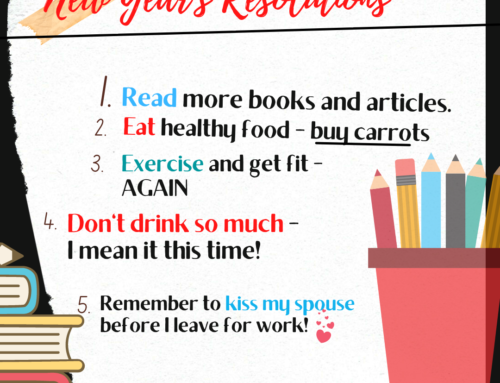What Do You See for 2020?
When I was looking ahead into 2020, I could not believe my luck.
January 1st (as you are now totally aware) the day of the year when so many people make bold statements to themselves about how they are going to show up in their world from that day onwards, arrived on a Wednesday – the very day of the week our email is sent out to around 1,800 inboxes around the world.
What better way to start the new year with a time-tested and proven system for improving every aspect of your life – including your workplace experience.
Looking back over my shoulder in past years, I credit one particular book with introducing me to the concept of self-improvement. It was in 1998 when I was 38 years old!
Your Best Year Yet
The book is Your Best Year Yet, written by Jinny Ditzler, and the strategies that Jinny outlined in the book immediately resonated with me and I adopted them into life from that moment on.
When concepts and ideas are provided to you that is a little at odds with what you have been used to hearing or seeing, it is often a matter of timing when the penny finally drops and sense-making occurs.
I had been hearing self-improvement ideas for a while but at the time, they had gone in one ear and out the other.
Then in 1998, when I was at a low point in my life, I found myself wandering around the self-aisle of the Chapters bookstore in Richmond, British Columbia, and Jinny’s book called out to me from the shelves.
Boy, did I ever need a Best Year Yet right then!
So, I took the book off the shelf and with my Starbucks coffee in hand, found a comfortable chair ion the store and started to read.
The ideas and concepts that Jinny shares in her 230-page book aren’t things that I hadn’t heard before but as I said before, timing is everything. And she provided a template, a roadmap, a how-to guide to “making the next twelve months the most successful ever.”
I decided that day to build my day-to-day, my week-to-week, and my month-to-month activities and plans around her ideas.
As far as I’m concerned, the results speak for themselves.
The essential premise behind Jinny’s suggestions is to cast a look over your shoulder at the preceding 12 months and ask yourself some hard questions and place the answers into two categories:
Here is a sample list for you to consider.
The Good Things
- What areas of your life were successful this year?
- List your top 3-5 accomplishments
- What do you feel contributed most to these accomplishments?
- What new skills did you learn or further develop?
- What positive habits did you cultivate?
- What do you wish you’d done more of?
- What was your most excited or happy moment?
The Not-So-Good Things
- What areas of your life were unsuccessful this year?
- What do you feel contributed most to these failures?
- What are your biggest lessons/takeaways from these?
- What unhealthy habits did you get into?
- What do you wish you had done differently?
- What do you wish you’d done less of?
- What was the cause of your most stress this year?
Henry Ford said once, “Failure is simply the opportunity to begin again, this time more intelligently.”
Makes total sense doesn’t it?
For me, as Jinny suggested, I was able to patterns of cause and effect in how the year had turned out and it inspired me to start making more decisions that would end up on the first list a year from now and less (aka none) that end up on the second list.
There are many ideas and concepts out there to help you.
Here are two others that are worth looking into:
- Best Self Co.
- Michael Hyatt’s ‘Your Best Year Ever’
Over Time
It is a question of developing positive new habits that can be sustained over time so that they can have an impact.
After all, isn’t the very definition of madness is to do the same thing over and over but expecting different results?
So, I started doing things differently.
For me, it was to follow Jinny’s advice and imagine what a successful year would look like if I was sitting down in 365 days time….and then come up with ten goals for the year. And then to break those goals down into smaller goals and then those smaller goals down into smaller goals still.
Write these goals down and visualize them being realized.
Each week, she told me to sit down and do “Gold Time” which is a chunk of time devoted to writing out those smaller, weekly goals, which when put together, week after week, month after month, would result in the year goals being achieved.
Project planning in its infancy for Phil but it worked!
And still, to this day, every Sunday, I spend time doing Gold Time planning in my journal (as I have done since 1998) to make sure that I am on track.
I (you) must check in with your progress regularly since it is very easy to stray off course and end up somewhere unintended if you are not paying attention.
As an example, if a plane was to travel from Los Angeles to New York is pointed only 1% off course when the plane is sitting on the tarmac in LA, it will ultimately end up 150 miles away from where it was supposed to land on the East Coast.
I am not saying that I have it all figured out because I don’t, but I got the message loud and clear that day in Richmond, a message that I had been hearing for years!
My shelves now play host to many self-improvement books and I choose to surround myself with positive people who see the world through a similar lens.
Not rose-colored but certainly a lens that is upbeat and optimistic.
Tony Robbins said once (actually he probably said it a million times), “If you do what you’ve always done, you’ll get what you’ve always gotten.”
To a spectacular 2020 for you!
In a few weeks, we will have some exciting news about the launch of the on-line Leadership Accelerator Program.
It is just one of our goals for this coming year to help you with yours.






